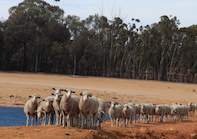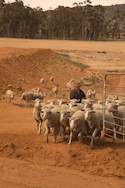Over the years, the Karoo has generated such a great reputation for the quality of its Karoo lamb and mutton that the Karoo Development Foundation was founded in 2009 to protect producers against falsely labelled produce and ensure the benefits of using the “Karoo” name flows back to communities in this region.

The non-profit organisation, Karoo Meat of Origin, was launched thereafter to specifically look at ways to protect Karoo lamb and mutton. The organisation represents over 200 small and large farms over an area of two million hectares.
Geographic Indicator
Karoo Meat of Origin has so far made several attempts to register Karoo lamb as a geographical indicator in the meat industry in South Africa, similar to Parma Ham and Parmigiano Reggiano cheese. The registration followed thirteen years of extensive research to confirm the meat from the region is truly unique and also to identify best ways to gain the full advantage of the geographic indicator.
A geographic indicator is not a brand, but an intellectual property right, belonging to a specific place of origin. It in effect does not belong to individuals, but protects a region from individual exploitation by people not from the region or fraudsters within the region.
Government in March 2019 published new regulations relating to the Protection of Geographical Indications used on Agricultural Products, in which Karoo Meat of Origin as well as Rooibos and Honeybush that will protect the use of these names in other countries.
Karoo Meat Production Regions
Only lamb and mutton born in the Karoo may be labelled as Karoo Meat, Karoo Lamb or Karoo Mutton. The region is a semi-desert area stretching over parts of the Northern Cape, Western Cape and Eastern Cape. Camdeboo, Beaufort West, Karoo Hoogland, Kareeberg, Ubuntu, Emthanjeni, Umsobomvu and Inxuba Yethemba are all part of this region.
Certification of Karoo Meat

Besides being born and bred in the Karoo, farmers need to comply with strict regulations for the meat to qualify as Karoo Meat. Amongst others, they need to prove they practice free range production on indigenous veldt, with rotation systems and stocking densities that are not damaging to the veld.
Sheep produced in this region, but finished in feedlots or raised on pasture, do not qualify to be sold under the geographic indicator, as these practices have a negative impact on the unique characteristics associated with Karoo Meat.
Sheep are not allowed to receive any growth stimulants, neither hormonal or antimicrobial, or preventative anti-microbial treatments. The animals also have to be handled in a way that does not compromise their welfare. For animal welfare reasons, sheep are not allowed to be transported for more than 250 km to an abattoir.
Abattoirs slaughtering animals for sale under the certification mark, need to be registered with the Red Meat Abattoir Association of South Africa and need to comply with very high standards. The abattoir also needs to use a specific roller mark and stamp on the carcasses.
The meat also needs to be sold by a certified packer, processor or abattoir. The whole chain is audited to ensure full traceability, conformance to food standards and legal requirements.
Taste
Research found that the Karoo vegetation gives a unique herbal flavour to mutton and lamb from these regions.
Use of Karoo Meat
Karoo meat can be used like mutton or lamb’s meat from any other region, with the part of the animal dictating the best way in which it should be prepared, ranging from usage in roasts to barbeques and stews.